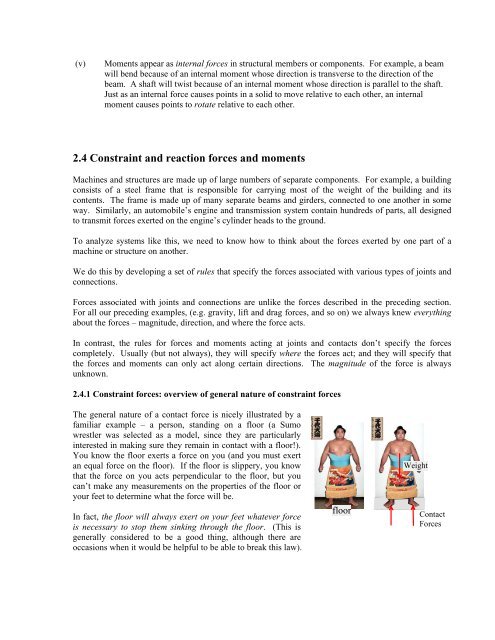Chapter 2 Review of Forces and Moments - Brown University
Chapter 2 Review of Forces and Moments - Brown University
Chapter 2 Review of Forces and Moments - Brown University
Create successful ePaper yourself
Turn your PDF publications into a flip-book with our unique Google optimized e-Paper software.
(v)<br />
<strong>Moments</strong> appear as internal forces in structural members or components. For example, a beam<br />
will bend because <strong>of</strong> an internal moment whose direction is transverse to the direction <strong>of</strong> the<br />
beam. A shaft will twist because <strong>of</strong> an internal moment whose direction is parallel to the shaft.<br />
Just as an internal force causes points in a solid to move relative to each other, an internal<br />
moment causes points to rotate relative to each other.<br />
2.4 Constraint <strong>and</strong> reaction forces <strong>and</strong> moments<br />
Machines <strong>and</strong> structures are made up <strong>of</strong> large numbers <strong>of</strong> separate components. For example, a building<br />
consists <strong>of</strong> a steel frame that is responsible for carrying most <strong>of</strong> the weight <strong>of</strong> the building <strong>and</strong> its<br />
contents. The frame is made up <strong>of</strong> many separate beams <strong>and</strong> girders, connected to one another in some<br />
way. Similarly, an automobile’s engine <strong>and</strong> transmission system contain hundreds <strong>of</strong> parts, all designed<br />
to transmit forces exerted on the engine’s cylinder heads to the ground.<br />
To analyze systems like this, we need to know how to think about the forces exerted by one part <strong>of</strong> a<br />
machine or structure on another.<br />
We do this by developing a set <strong>of</strong> rules that specify the forces associated with various types <strong>of</strong> joints <strong>and</strong><br />
connections.<br />
<strong>Forces</strong> associated with joints <strong>and</strong> connections are unlike the forces described in the preceding section.<br />
For all our preceding examples, (e.g. gravity, lift <strong>and</strong> drag forces, <strong>and</strong> so on) we always knew everything<br />
about the forces – magnitude, direction, <strong>and</strong> where the force acts.<br />
In contrast, the rules for forces <strong>and</strong> moments acting at joints <strong>and</strong> contacts don’t specify the forces<br />
completely. Usually (but not always), they will specify where the forces act; <strong>and</strong> they will specify that<br />
the forces <strong>and</strong> moments can only act along certain directions. The magnitude <strong>of</strong> the force is always<br />
unknown.<br />
2.4.1 Constraint forces: overview <strong>of</strong> general nature <strong>of</strong> constraint forces<br />
The general nature <strong>of</strong> a contact force is nicely illustrated by a<br />
familiar example – a person, st<strong>and</strong>ing on a floor (a Sumo<br />
wrestler was selected as a model, since they are particularly<br />
interested in making sure they remain in contact with a floor!).<br />
You know the floor exerts a force on you (<strong>and</strong> you must exert<br />
an equal force on the floor). If the floor is slippery, you know<br />
that the force on you acts perpendicular to the floor, but you<br />
can’t make any measurements on the properties <strong>of</strong> the floor or<br />
your feet to determine what the force will be.<br />
In fact, the floor will always exert on your feet whatever force<br />
is necessary to stop them sinking through the floor. (This is<br />
generally considered to be a good thing, although there are<br />
occasions when it would be helpful to be able to break this law).<br />
floor<br />
Weight<br />
Contact<br />
<strong>Forces</strong>
















